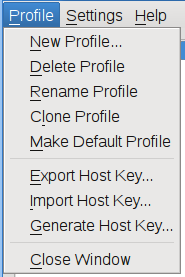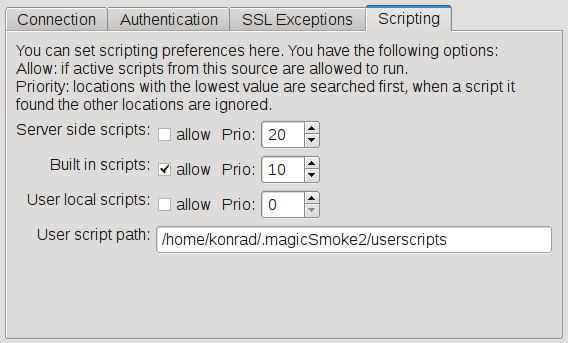
A profile is created by chosing "Profile" - "New Profile..." from the menu.

In the picture above you can see the connection settings. The URL must contain the complete path to the machine.php file - the MagicSmoke client forces this URL to start with "https://". The settings below are used if you have to connect through a web proxy - check the "Proxy" checkbox to activate proxy support.
The profile that is displayed bold is the default profile. The default profile is the one that is pre-selected when MagicSmoke is started.
The Profile menu allows you to manipulate profiles:

Below you see the Authentication tab, which defines how the MagicSmoke client authenticates to the server:
You can manipulate host keys through the "Profile" menu:

The "SSL Exceptions" tab (below) can be used to allow the use of self-signed certificates for MagicSmoke servers. Normally the SSL engine used by MagicSmoke insists that the server's connection is properly authenticated down to a root certificate known to the operating system. To configure these connections click the "Probe Server" - MagicSmoke will either tell you that the connection was successful or what errors occurred. Check the finger print - if it matches accept the errors - from now on MagicSmoke will compare all errors it encounters with the recorded finger print and stored errors and accepts the connection if they match.

The "Scripting" tab (below) defines whether any scripts are performed by the client and which source of scripts are accepted.

Server side scripts: it is possible to store scripts on the server. If allowed, MagicSmoke downloads those scripts and executes them at specific times. Since scripts can access any part of the program and even the underlying system, you should allow this only for servers that you trust.
Built in scripts: MagicSmoke comes with some very basic scripts built in. Use these if you do not allow any other scripts.
User local scripts: scripts can also be installed locally - either to overide the server scripts or to use a known good version copied from the server. The User script path setting tells MagicSmoke where to find those local scripts.

Using the Language... menu item you can chose between all installed translations - the new translation becomes active after a restart of MagicSmoke.
The OpenOffice.org Settings... allow you to define how MagicSmoke interfaces with OpenOffice or LibreOffice version 3.x. OpenOffice is used to create and print reports, bills, etc.
Available options are:

The Set Default Label Font... allows you to chose a fall-back font for labels (tickets and vouchers) if they do not contain their own font or the font inside them cannot be interpreted by the MagicSmoke.
The Set Application Style... menu item allows you to change how MagicSmoke looks.